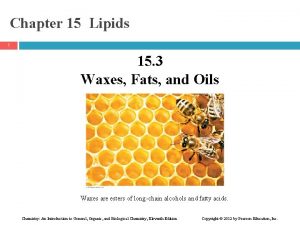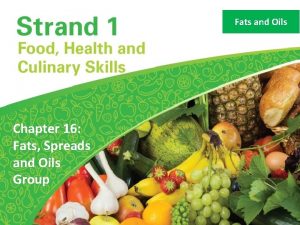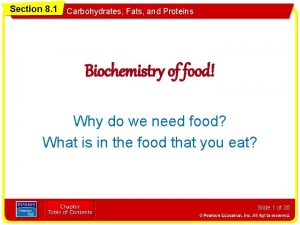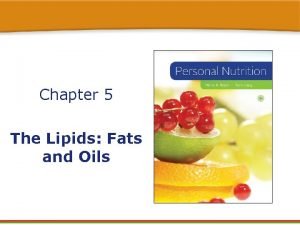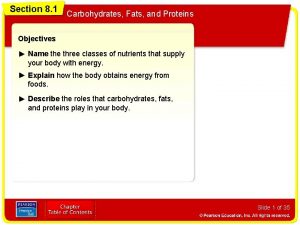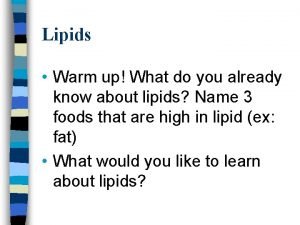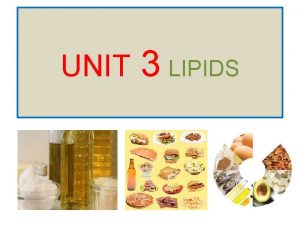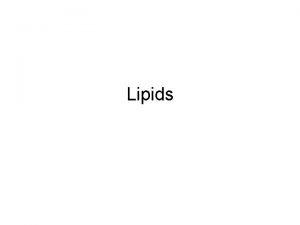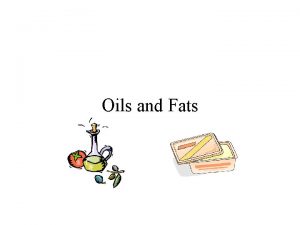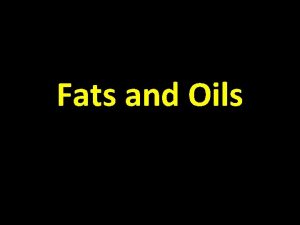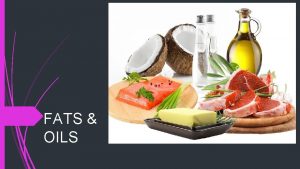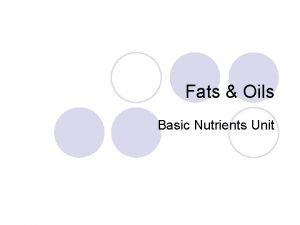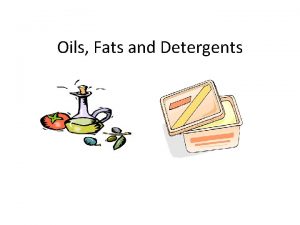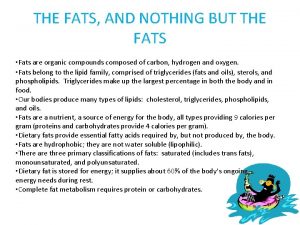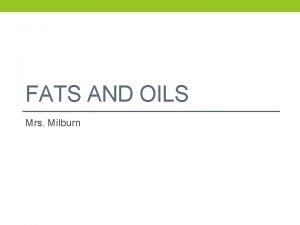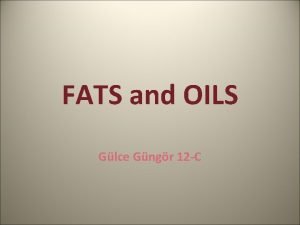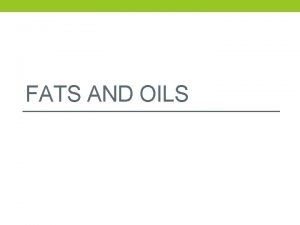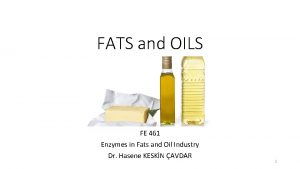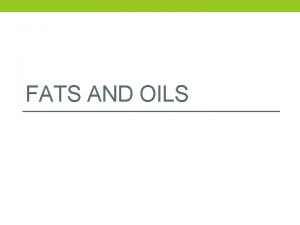Chemical Properties of fats and oils oils 1













- Slides: 13

Chemical Properties of fats and oils: oils 1 -Hydrolysis: • They are hydrolyzed into their constituents (fatty acids and glycerol) by the action of super heated steam, acid, alkali or enzyme (e. g. , lipase of pancreas). • - During their enzymatic and acid hydrolysis glycerol and free fatty acids are produced.

2 -Saponification. Alkaline hydrolysis produces glycerol and salts of fatty acids (soaps). • Soaps cause emulsification of oily material this help easy washing of the fatty materials

3 -Hydrogenation or hardening of oils: oils • It is a type of addition reactions accepting hydrogen at the double bonds of unsaturated fatty acids. • The hydrogenation is done under high pressure of hydrogen and is catalyzed by finely divided nickel or copper and heat. • It is the base of hardening of oils (margarine manufacturing), e. g. , change of oleic acid of fats (liquid) into stearic acid (solid).

4 -Oxidation(Rancidty) • This toxic reaction of triglycerides leads to unpleasant odour or taste of oils and fats developing after oxidation by oxygen of air, bacteria, or moisture. • Also this is the base of the drying oils after exposure to atmospheric oxygen. Example is linseed oil, which is used in paints and varnishes manufacturing

Rancidity Definition: • It is a physico-chemical change in the natural properties of the fat leading to the development of unpleasant odor or taste or abnormal color particularly on aging after exposure to atmospheric oxygen, light, moisture, bacterial or fungal contamination and/or heat. • Saturated fats resist rancidity more than unsaturated fats that have unsaturated double bonds.

Types and causes of Rancidity: 1. Hydrolytic rancidity 2. Oxidative rancidity 3. Ketonic rancidity 1 -Hydrolytic rancidity: rancidity • It results from slight hydrolysis of the fat • by lipase from bacterial contamination leading to the liberation of free fatty acids and glycerol at high temperature and moisture. Volatile short-chain fatty acids have unpleasant odor.


2 -Oxidative Rancidity: Rancidity • It is oxidation of fat or oil catalyzed by exposure to oxygen, light and/or heat producing peroxide derivatives e. g. , peroxides, aldehydes, ketones and dicarboxylic acids that are toxic and have bad odor. • This occurs due to oxidative addition of oxygen at the unsaturated double bond of unsaturated fatty acid of oils.

Hazards of Rancid Fats: 1. The products of rancidity are toxic, i. e. , causes food poisoning and cancer. 2. Rancidity destroys the fat-soluble vitamins (vitamins A, D, K and E). 3. Rancidity destroys the polyunsaturated essential fatty acids.

1 -Iodine number (or value): • Definition: It is the number of grams of iodine absorbed by 100 grams of fat or oil. • Uses: It is a measure for the degree of unsaturation of the fat, as a natural property for it. • Unsaturated fatty acids absorb iodine at their double bonds, therefore, as the degree of unsaturation increases iodine number and hence biological value of the fat increase.

A-Phospholipids Definition: Phospholipids or phosphatides are compound lipids, which contain phosphoric acid group in their structure. Sources: They are found in all cells (plant and animal), milk and egg-yolk in the form of lecithins. Structure: Structure phospholipids are composed of: Fatty acids (a saturated an unsaturated fatty acid). 1. Nitrogenous base (choline, serine, threonine, or ethanolamine). 2. Phosphoric acid. 3. Fatty alcohols (glycerol, inositol or sphingosine).

C-Lipoproteins • Definition: Lipoproteins are lipids combined with proteins in the tissues. The lipid component is phospholipid, cholesterol or triglycerides. The holding bonds are secondary bonds. • They include: 1. Structural lipoproteins: These are widely distributed in tissues being present in cellular and subcellular membranes. In lung tissues and In the eye. • Transport lipoproteins: • These are the forms present in blood plasma. They are composed of a protein called apolipoprotein and different types of lipids. (Cholesterol, cholesterol esters, phospholipids and triglycerides). As the lipid content increases, the density of plasma lipoproteins decreases

Very low-density lipoproteins (VLDL) : They contain about 7 -10% protein and 90 -93% lipid. The lipid content is mainly triglycerides formed in the liver. They contain phospholipid and cholesterol b) Low-density lipoproteins (LDL) They contain 10 -20% proteins in the form of apolipoprotein. Their lipid content varies from 8090%. They contain about 60% of total blood cholesterol and 40% of total blood phospholipids. c) High-density lipoproteins (HDL) : They contain 35 -55% proteins in the form of apolipoprotein. They contain 45 -65% lipids formed of cholesterol (40% of total blood content) and phospholipids (60% of total blood content).
 Are lipids long term energy storage
Are lipids long term energy storage Waxes
Waxes Definition of lipids
Definition of lipids What biomolecule transports substances in and out of cells
What biomolecule transports substances in and out of cells Fats spreads and oils
Fats spreads and oils Non polar molecules that include fats oils and cholesterol
Non polar molecules that include fats oils and cholesterol Chemical property definition
Chemical property definition Section 8-1 carbohydrates fats and proteins answer key
Section 8-1 carbohydrates fats and proteins answer key Are fats and lipids the same thing
Are fats and lipids the same thing Section 8-1 carbohydrates fats and proteins answer key
Section 8-1 carbohydrates fats and proteins answer key Venn diagram of saturated and unsaturated fats
Venn diagram of saturated and unsaturated fats Saponifiable and non saponifiable lipids
Saponifiable and non saponifiable lipids Solid fats and added sugars
Solid fats and added sugars Fats and lipids
Fats and lipids

